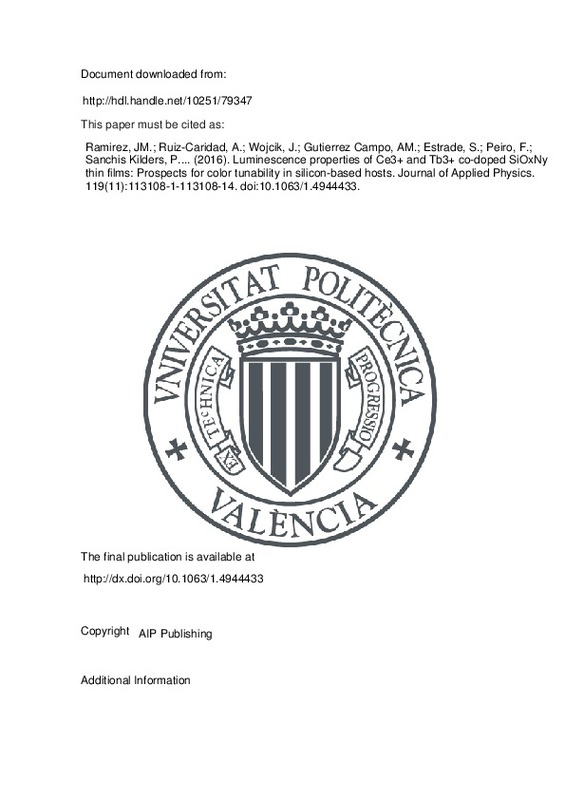JavaScript is disabled for your browser. Some features of this site may not work without it.
Buscar en RiuNet
Listar
Mi cuenta
Estadísticas
Ayuda RiuNet
Admin. UPV
Luminescence properties of Ce3+ and Tb3+ co-doped SiOxNy thin films: Prospects for color tunability in silicon-based hosts
Mostrar el registro sencillo del ítem
Ficheros en el ítem
| dc.contributor.author | Ramirez, J. M.
|
es_ES |
| dc.contributor.author | Ruiz-Caridad, A.
|
es_ES |
| dc.contributor.author | Wojcik, J.
|
es_ES |
| dc.contributor.author | Gutiérrez Campo, Ana María
|
es_ES |
| dc.contributor.author | Estrade, S.
|
es_ES |
| dc.contributor.author | Peiro, F.
|
es_ES |
| dc.contributor.author | Sanchis Kilders, Pablo
|
es_ES |
| dc.contributor.author | Mascher, P.
|
es_ES |
| dc.contributor.author | Garrido, B.
|
es_ES |
| dc.date.accessioned | 2017-04-03T07:42:33Z | |
| dc.date.available | 2017-04-03T07:42:33Z | |
| dc.date.issued | 2016-03-21 | |
| dc.identifier.issn | 0021-8979 | |
| dc.identifier.uri | http://hdl.handle.net/10251/79347 | |
| dc.description.abstract | In this work, the role of the nitrogen content, the annealing temperature, and the sample morphology on the luminescence properties of Ce3+ and Tb3+ co-doped SiOxNy thin films has been investigated. An increasing nitrogen atomic percentage has been incorporated in the host matrix by gradually replacing oxygen with nitrogen during fabrication while maintaining the Si content unaltered, obtaining a sequential variation in the film composition from nearly stoichiometric SiO2 to SiOxNy. The study of rare earth doped single layers has allowed us to identify the parameters that yield an optimum optical performance from Ce3+ and Tb3+ ions. Ce3+ ions proved to be highly sensitive to the annealing temperature and the nitrogen content, showing strong PL emission for relatively low nitrogen contents (from 0 to 20%) and moderate annealing temperatures (800-1000 degrees C) or under high temperature annealing (1180 degrees C). Tb3+ ions, on the other hand, displayed a mild dependence on those film parameters. Rare earth co-doping has also been investigated by comparing the luminescence properties of three different approaches: (i) a Ce3+ and Tb3+ co-doped SiOxNy single layer, (ii) a bilayer composed of two SiOxNy single layers doped with either Ce3+ or Tb3+ ions, and (iii) a multilayer composed of a series of either Tb3+ or Ce3+-doped SiOxNy thin films with interleaved SiO2 spacers. Bright green emission and efficient energy transfer from either Ce3+ ions or Ce silicates to Tb3+ ions has been observed in the co-doped single layer as a consequence of the strong ion-ion interaction. On the other hand, independent luminescence from Ce3+ and Tb3+ ions has been observed in the Ce3+ and Tb3+ co-doped bilayer and multilayer, providing a good scenario to develop light emitting devices with wide color tunability by varying the number of deposited films that contain each rare earth dopant. Moreover, the optoelectronic properties of Ce3+-and/or Tb3+-doped thin films have been studied by depositing transparent conductive electrodes over selected samples. An electroluminescence signal according to the rare earth transitions is obtained in all cases, validating the excitation of Ce3+ and Tb3+ ions upon electron injection. Also, the main charge transport of injected electrons has been evaluated and correlated with the layer stoichiometry. Finally, a simple reliability test has allowed disclosing the origin of the early breakdown of test devices, attributed to the excessive joule heating at filament currents that occur around a region close to the polarization point. (C) 2016 AIP Publishing LLC. | es_ES |
| dc.description.sponsorship | This research was supported by the Spanish Ministry of Science and Innovation (TEC2012-38540-C02-01). RBS characterization was performed in the Tandetron Accelerator Laboratory at Western University in London, ON (Canada). TEM characterization was carried out in the Science and Technical Centers (CCiT) of the University of Barcelona. In Canada, this work was supported by the Natural Sciences and Engineering Research Council (NSERC) under the Discovery Grants program. | en_EN |
| dc.language | Inglés | es_ES |
| dc.publisher | AIP Publishing | es_ES |
| dc.relation.ispartof | Journal of Applied Physics | es_ES |
| dc.rights | Reserva de todos los derechos | es_ES |
| dc.subject.classification | TEORIA DE LA SEÑAL Y COMUNICACIONES | es_ES |
| dc.title | Luminescence properties of Ce3+ and Tb3+ co-doped SiOxNy thin films: Prospects for color tunability in silicon-based hosts | es_ES |
| dc.type | Artículo | es_ES |
| dc.identifier.doi | 10.1063/1.4944433 | |
| dc.relation.projectID | info:eu-repo/grantAgreement/MINECO//TEC2012-38540-C02-01/ES/ILUMINACION DE ESTADO SOLIDO INNOVADORA E INTELIGENTE E INTERCONEXIONES OPTICAS A 1.5 MICRAS CON FOTONICA DE SILICIO BASADA EN TECNOLOGIA CMOS/ | es_ES |
| dc.rights.accessRights | Abierto | es_ES |
| dc.contributor.affiliation | Universitat Politècnica de València. Escuela Técnica Superior de Ingenieros de Telecomunicación - Escola Tècnica Superior d'Enginyers de Telecomunicació | es_ES |
| dc.contributor.affiliation | Universitat Politècnica de València. Instituto Universitario de Tecnología Nanofotónica - Institut Universitari de Tecnologia Nanofotònica | es_ES |
| dc.description.bibliographicCitation | Ramirez, JM.; Ruiz-Caridad, A.; Wojcik, J.; Gutiérrez Campo, AM.; Estrade, S.; Peiro, F.; Sanchis Kilders, P.... (2016). Luminescence properties of Ce3+ and Tb3+ co-doped SiOxNy thin films: Prospects for color tunability in silicon-based hosts. Journal of Applied Physics. 119(11):113108-1-113108-14. https://doi.org/10.1063/1.4944433 | es_ES |
| dc.description.accrualMethod | S | es_ES |
| dc.relation.publisherversion | http://dx.doi.org/10.1063/1.4944433 | es_ES |
| dc.description.upvformatpinicio | 113108-1 | es_ES |
| dc.description.upvformatpfin | 113108-14 | es_ES |
| dc.type.version | info:eu-repo/semantics/publishedVersion | es_ES |
| dc.description.volume | 119 | es_ES |
| dc.description.issue | 11 | es_ES |
| dc.relation.senia | 325750 | es_ES |
| dc.contributor.funder | Ministerio de Economía y Competitividad | es_ES |
| dc.contributor.funder | Natural Sciences and Engineering Research Council of Canada | es_ES |







![[Cerrado]](/themes/UPV/images/candado.png)

